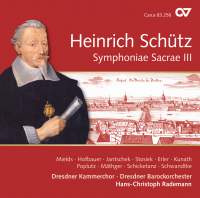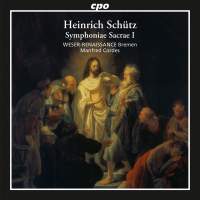Texte paru dans: / Appeared in:
|
|||||||
|
Outil de traduction (Très approximatif) |
|||||||
|
Reviewer:
Fabrice Fitch These two ensembles are (along with Cantus Cölln) among the finest and most prolific exponents of Schütz on CD. With these new recordings they each begin tackling the monumental series of Symphoniae sacrae, published at intervals between 1629 and 1650. The first volume sets Latin works exclusively and (as the booklet-note remarks) is something of an outlier within the composer’s output. Most striking perhaps is the handful of settings from the Song of Songs, in which Schütz taps a vein that more than recalls his Italian colleagues in a similar idiom. They are wonderfully expressive, making one lament anew the total loss of the composer’s music for the stage. Manfred Cordes, as usual in Schütz (only his Cantiones sacrae volume disappointed), has assembled a very fine cast of soloists who functions equally well as an ensemble. But the number of singing parts is comparatively small compared to the set’s total instrumental requirements: players outnumber singers by three to one, with cornetts, sackbuts and dulcians appearing in groups of two, three and four. The three dulcians of In lectulo per noctes and the four sackbuts of Fili mi, Absalon are especially memorable. That said, one hesitates to single out particular pieces when there is so much to appreciate. When the first set was published, the Thirty Years War was in full swing, bringing with it a reduction of the forces available to the composer; but by the time Symphoniae sacrae III was issued, it was possible once again for Schütz to envisage pieces on the scale of the Psalmen Davids of his youth. (The magnificent Nun danket alle Gott that closes the set must have referred to the war’s end.) Here, polychoral music predominates, and the individual pieces are commonly on a grander scale (the odd miniature, such as the famous Saul, Saul, was verfolgst du mich, notwithstanding). As in their Psalmen Davids set, the Dresdner Kammerchor distinguish between the choirs by opposing soloists in one choir and ensemble in the other, complemented by instruments. This sets it apart from Cantus Cölln, their rivals in both sets, who opt for solo voices all round. The dispute on this point, though not quite as heated as with Bach, is a significant one within Schütz scholarship; but to the neutral observer the distinction is welcome in that there is so little to choose between the two ensembles in terms of quality or approach. I said much the same in my review of the Psalmen Davids a couple of years ago (1/14), though in this case it’s perhaps Rademann’s team who edge it, on account of their fuller sound (which, I should stress, is not only a matter of the number of voices).
|
|||||||
|
|
|
||||||
|
Cliquez l'un ou l'autre
bouton pour découvrir bien d'autres critiques de CD |
|||||||





